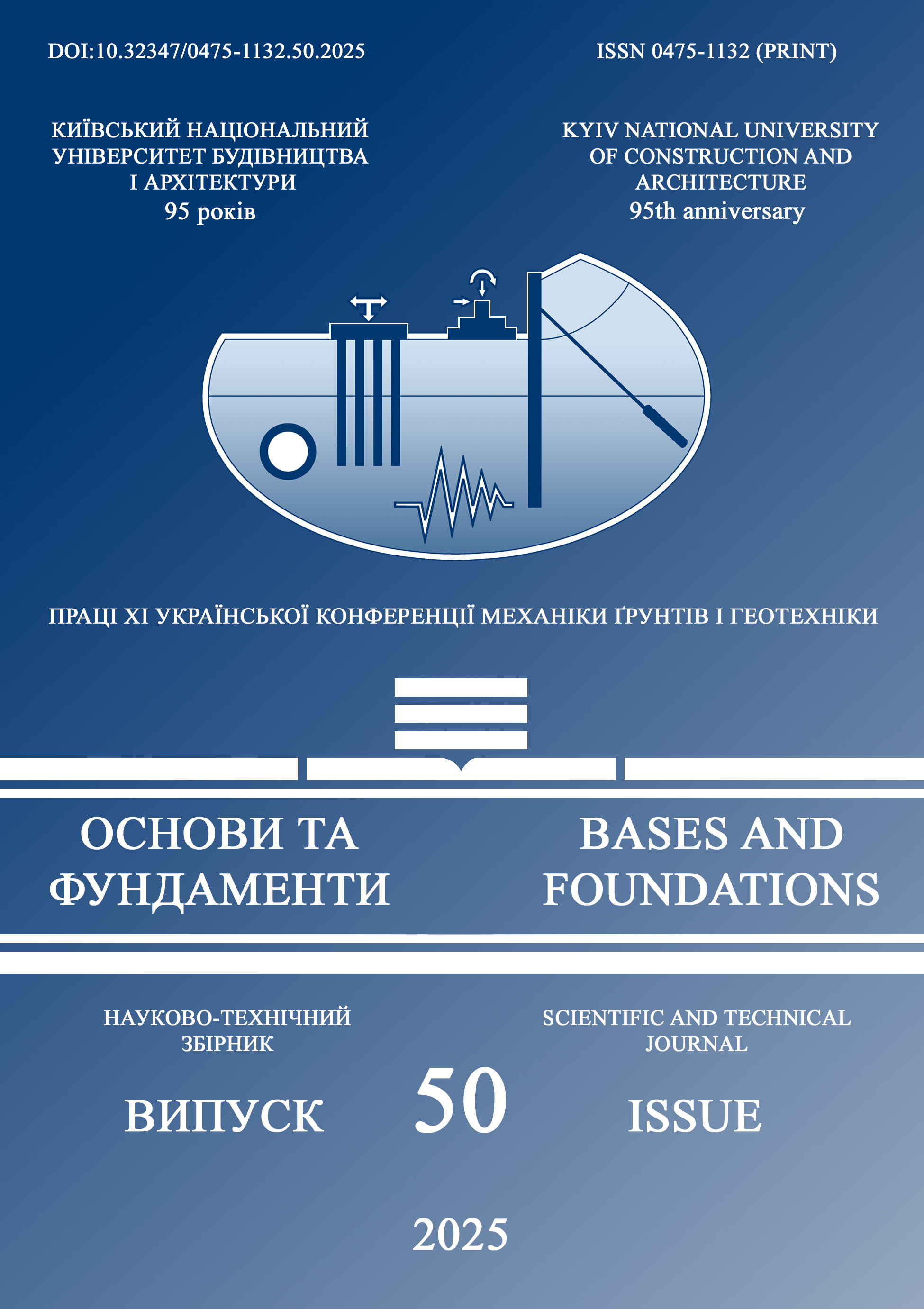Тиксотропні властивості намивних ґрунтів хвостосховищ – геофізичні критерії прогнозу
Основний зміст сторінки статті
Анотація
Хвостосховища крупних гірничо-збагачувальних комбінатів відносяться до особливо відповідальних споруд (клас наслідків СС3), руйнування яких може спричинити важкі екологічні та соціально-економічні наслідки. Одним з факторів, що впливають на безпеку функціонування подібних об'єктів, є сильні сейсмічні впливи, викликані землетрусами тектонічної та техногенно-індукованої природи. Хвостосховища є техногенними об'єктами, що істотно змінюють інженерно-геологічну та ландшафтну обстановку територій. Антропогенні зміни геологічного середовища, що пов’язані з будівництвом і експлуатацією хвостосховищ значно впливають і на локальні зміни сейсмічності.
При нарощуванні об’ємів хвостосховищ в основі огороджуючих дамб наступних ярусів розташовані низькошвидкісні, обводнені техногенні ґрунти. При проектуванні цих споруд необхідно враховувати можливість розрідження ґрунтів у їх основі.
В роботі обговорюються результати апробації підходів оцінки сейсмічного розрідження техногенних ґрунтів за геофізичними даними в умовах хвостосховищ гірничо-збагачувальних комбінатів Криворізького залізорудного басейну.
Показано, що основними геофізичними факторами, які визначають можливість розрідження, є значення прогнозних пікових горизонтальних прискорень поверхні ґрунту та закон зміни швидкості поперечних хвиль з глибиною. Істотний вклад робить і глибина досліджуваної точки в розрізі. Для точок, розташованих нижче рівня ґрунтових вод (РГВ), варіації положення РГВ і щільності ґрунту вище і нижче РГВ (для фізично реальних ситуацій) впливають на потенціал розрідження істотно менше, ніж перераховані вище фактори.
Обґрунтовано перспективи геофізичної оцінки динамічної стійкості ґрунтів техногенних об’єктів. Вперше цей підхід було випробувано на території хвостосховищ гірничо-збагачувальних комбінатів України. Розглянуто отримані авторами результати оцінки можливості сейсмічного розрідження низькошвидкісних техногенних ґрунтів на підставі свердловинної та польової сейсморозвідки на одному з хвостосховищ Кривого Рогу. Підхід, який використовується, є перспективною альтернативою або доповненням до підходів, що базуються на пенетраційних властивостях, та істотно підвищить достовірність прогнозу можливості розрідження техногенних ґрунтів у разі динамічного впливу різної природи.
Блок інформації про статтю

Ця робота ліцензується відповідно до Creative Commons Attribution 4.0 International License.
Автори, які публікуються у цьому журналі, погоджуються з наступними умовами: Автори залишають за собою право на авторство своєї роботи та передають журналу право першої публікації цієї роботи на умовах ліцензії Creative Commons Attribution License, котра дозволяє іншим особам вільно розповсюджувати опубліковану роботу з обов'язковим посиланням на авторів оригінальної роботи та першу публікацію роботи у цьому журналі. Автори мають право укладати самостійні додаткові угоди щодо неексклюзивного розповсюдження роботи у тому вигляді, в якому вона була опублікована цим журналом (наприклад, розміщувати роботу в електронному сховищі установи або публікувати у складі монографії), за умови збереження посилання на першу публікацію роботи у цьому журналі. Політика журналу дозволяє і заохочує розміщення авторами в мережі Інтернет (наприклад, у сховищах установ або на особистих веб-сайтах) рукопису роботи, як до подання цього рукопису до редакції, так і під час його редакційного опрацювання, оскільки це сприяє виникненню продуктивної наукової дискусії та позитивно позначається на оперативності та динаміці цитування опублікованої роботи (див. The Effect of Open Access).Посилання
Pihulevskyi, P. H., Kendzera, O. V., Babii, K. V., Anisimova, L. B., & Kyryliuk, O. S. (2023). Connection of Kryvbas tectonics with natural and technogenic seismici-ty. Natsional'nyi Hirnychyi Universytet. Naukovyi Visnyk, (2), 5-10.
Pigulevskiy, P., & Svistun, V. K. (2021, September). Influence of technogenic ob-jects on the development of landslides in the South of Kryvbass. In Third EAGE Work-shop on Assessment of Landslide Hazards and Impact on Communities (Vol. 2021, No. 1, pp. 1-5). European Association of Geosci-entists & Engineers.
Voznesensky, E. A. (1998). Earthquakes and soil dynamics. Educational Journal of So-ros, 2, 101-108.
Nemchynov, I., Maryenkov, N., Babik, K., Khavkin, A., Poklonsky, V., Fesenko, O., ... & Sklyar, A. (2017). New generation build-ing code DBNV. 1.-1-12: 2014" Construc-tion in seismic regions of Ukraine". 6th World Conference on Earthquake (16WCEE), Santiago Chile, January 9th to 13th.
Seed, R. B., Cetin, K. O., Moss, R. E., Kam-merer, A. M., Wu, J., Pestana, J. M., ... & Faris, A. (2003). Recent advances in soil liq-uefaction engineering: a unified and con-sistent framework. In Proceedings of the 26th Annual ASCE Los Angeles Geotechnical Spring Seminar: Long Beach, CA.
Ronald, D., Andrus, Kenneth H., & Stokoe K.H. Liquefaction resistance of soils from shear wave velocity. Journal of geotechnical and geoenvironmental engineering. Vol. 126 (11).
Andrus, R.D. & Stokoe, K.H. ‘‘Liquefaction resistance based on shear wave velocity.’’ Proc., (1997). NCEER Workshop on Evalua-tion of Liquefaction Resistance of Soils, Na-tional Center for Earthquake Engineering Research, Buffalo, 9, 128.
Ronald, D., Andrus, Kenneth, H., Stokoe, Riley, M. & Chung (1999). Draft guidelines for evaluating liquefaction resistance using shear wave velocity measurements and sim-plified procedures. Building and Fire re-search laboratory, National institute of standarts and technology, Gaidhersburg, MD 20899.
Youd, T. L., Idriss, I. M., Andrus, R. D. & et. al. (2001): Liquefaction resistance of soils summary report from 1996 NCEER and 1998 NCEER/NSF workshops on Evaluation of Liquefaction Resistance of Soil, J. Ge-otech. Geoenviron. Eng., (127), 817–833.
Dovbnich, M.M., & Ananchenko, M.Y. (2015). Geophysical criteria for seismic liq-uefaction of tailings anthropogenic soils of ore-dressing and processing enterprises of Ukraine. Naukovyi Visnyk NGU. (1), 8-15.
